Greatest Native Americans of All Time
Long before the arrival of the first European explorers, the people who lived in what is now United States had a thriving society and developed culture. These people are called Native Americans, i.e. the indigenous peoples of North and South America. The landscape was dominated by powerful tribes or nations, from the Comanche to Arapaho in the middle of the U.S., to the Seminole and the Cherokee in the Southeast of our nation. Often times those tribes and nations were led by powerful chiefs and warrior elders.
Below is a quick presentation of the most famous Native Americans who left an indelible mark on their people and the United States as a nation.
Sitting Bull (c.1831-1890)
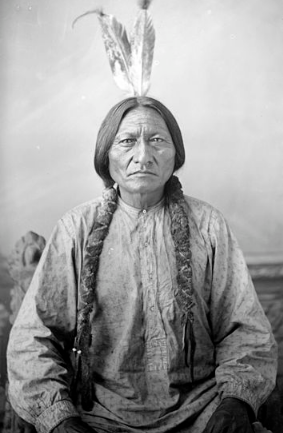
Born at a place called Many-Caches, Sitting Bull was the Supreme Chief of the Lakota Sioux Indians. Nicknamed “Slow”, Sitting Bull is best known for leading a coalition of Native American tribes at the Battle of Little Bighorn in 1876.
Hailing from the famous and powerful Lakota Sioux people, Sitting Bull enters this list of greatest Native Americans due to his leadership prowess during battles. This Lakota Sioux chief, who lived between 1831 and 1890, found a way of bringing warriors from different tribes, including Arapahoe and Cheyenne, to fight their common enemy, i.e. the white man.
Arguably one of the fiercest confrontations between Native American Indians and the United States government, the Battle of Little Big Horn in 1876 witnessed a total destruction of U.S. Colonel Custer’s men. Sitting Bull and his fellow warriors killed Colonel Custer and many of his vastly outnumbered men. The battle went down in history as one of the most famous wins secured by the Native Americans against the US forces.
As more and more armed and well-trained U.S. soldiers poured into the Black Hills, Sitting Bull found it increasingly difficult to fend of attacks by the U.S. government. In 1881, he surrendered to the government. He was committed to spend the remainder of his life in a reservation.
In 1890, Sitting Bull died during a violent skirmish between the reservation police and his followers.

The reason Sitting Bull waged war against the U.S. government was a very peculiar one. Gold had been discovered in Sitting Bull’s homeland in the Black Hills of South Dakota, and the U.S. government was determined to get the indigenous population out of the way so they could mine the minerals. Sitting Bull vehemently opposed living inside the reservations that the U.S. government had created for them. The Lakota Sioux chief would not back down; he fought tooth and nail to halt further incursions made by the white settlers.
Did you know: Sitting Bull was born to a powerful Lakota Sioux warrior called Jumping Bull?
Crazy Horse (c. 1840-1877)
Born around 1840 in present-day South Dakota, Crazy Horse was a famous Native American warrior from the Sioux tribe. This Native American was most known for leading the Sioux to battle against the U.S. government.
Crazy Horse was a fierce warrior whose nickname at birth was Curly. He was also known as Cha-O-Ha which translates to “Among the Trees”. His agility and bravery was evident right from an early age, as he was one the best hunters of buffalo in his tribe.
Crazy Horse got his name from his father Tashunka Witco, who was also known as Crazy Horse. Resolute and unyielding to the incursion made by the U.S. government, Crazy Horse fought hard to defend his people’s ways of living. Contrary to his name, he was anything but crazy; instead he was described as very calm and collected leader. That in no way took anything from his fearless attitude in battle.
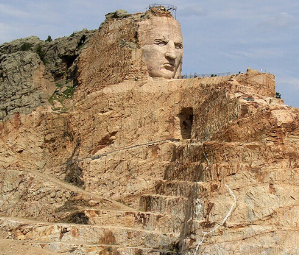
Crazy Horse’s parents were Rattling Blanket Woman and Crazy Horse. One of his children, a daughter, was called They Are Afraid of Her.| Image: Crazy Horse Monument in South Dakota, U.S.
After a misunderstanding between a group of U.S. soldiers and his Sioux tribe, a vicious war erupted between the Sioux Nation and the federal government. The Sioux nation took arms against the U.S. to avenge their slain chief called Conquering Bear. From then onward, Crazy Horse led Sioux warriors in many raids to drive out white settlers on their land.
During the Battle of Little Big Horn (1876), Crazy Horse fought gallantly alongside another famous Native American chief by the name of Sitting Bull. The battle ended in a resounding win for the Native Americans as US Colonel George Custer and his men capitulated to Crazy Horse’s men.
Unfortunately for the Sioux people, Crazy Horse was betrayed by one his tribe men and then forced to hand himself over to the U.S. government at Fort Robinson in Nebraska. It was at that very fort, in 1877, that this Native American hero took his last breath.
Did you know: Crazy Horse vehemently declined to have his picture taken as he believed that camera trapped the soul of the individual?
Sacagawea (1788-1812)
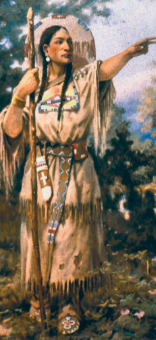
Sacagawea’s journey with explorers Lewis and Clark began in April 1805. In spite of the absolutely horrific conditions and terrain, Sacagawea is said to have kept the spirit in the expedition high. Her presence also meant that Native American tribes perceived the explorers as folks that came in peace.
A Shoshone Indian tribe woman, Sacagawea (or Sacajawea) etched her name into the history annals for being the guide that helped explorers Lewis and Clark make their famed expedition to the Pacific Ocean.
Sacagawea was born around 1788 in the Lemhi River Valley, Idaho. It’s been said that she grew up in a village near the Rocky Mountains in present day Idaho. Her father was famous tribe chief of the village.
Just before her teens, her village was attacked by the rival tribe Hidatsa. She, along with many of village folks, was taken prisoners and then sold as a slave. The Hidatsa tribe later on sold her to a French-Canadian trapper called Charbonneau, who ended up marrying her.
Her rise to prominence came when she volunteered to act as a guide and interpreter in Lewis and Clark Expedition of 1804. The expedition, which was sanctioned by then-U.S. President Thomas Jefferson, was to explore the vast lands to the west that came with the Louisiana Purchase in 1803. Along with explorers Lewis and Clark, Sacagawea traveled up the Missouri River, making their way through some of the most treacherous mountain ranges and paths, and then finally made it to the Pacific Ocean in November 1805.
A determined young woman, Sacagawea carried her infant son along the expedition. Her contribution to the expedition was invaluable as she helped steer the explorers from violent Native American tribes. She also showed the expedition what food or fruits were safe for eating. And she famously plunged into freezing cold water to salvage the expedition’s supplies, books and charts when the boat they were travelling on capsized.
Had it not been for the presence of Sacagawea and the baby that she was nursing, we shudder to think what would have happened to Lewis and Clark during the expedition. The sight of a woman carrying a baby in a cradleboard allowed the expedition to look non-threatening.
Sacagawea and the Lewis and Clark expedition returned home in 1806. Upon their arrival, the captains of the expedition received all the fame and glory, while Sacagawea’s contribution was barely mentioned. She faded into obscurity, and there is hardly any proper record of her life after the expedition. There were reports that she went back to the Shoshone, where she spent the remainder of her life until her death on April 9, 1884. A different account says that she died of fever on December 20, 1812.
Did you know: During the expedition, Sacajawea displayed a remarkable act of kindness when she traded in her beaded belt for fur coat for then-U.S. President Thomas Jefferson?
Geronimo (1829-1909)
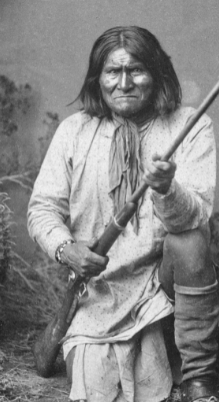
Geronimo was a Native American warrior and leader of the Chiracahua Apache tribe. He is most known for mounting a strong resistance against both the U.S. and Mexican governments. Born in eastern Arizona around 1829, Geronimo grew up feeling very bitter about the manner in which the United States and Mexico treated his people, the Apache. The two countries took seized large parts of Geronimo’s tribe’s land.
Geronimo’s parents were The Grey One and Juana. He had many brothers and sisters; and together with his brothers, he would hunt and train to become a warrior. He developed the skills to hunt all kinds of animals, including mountain lions, bears, and deer. His training in the wild and under harsh weather conditions made him an even fearless warrior in the Apache tribe.
In his late teens, Geronimo married a young and beautiful girl called Alope. For the girl’s bride price, he presented many horses to girl’s father. The marriage produced three children.
Tragedy struck Geronimo when a group of Mexicans raided his camp, killing his wife, children and mother. Heart broken and dismayed, Geronimo swore to avenge their deaths. In his delirious state, it is said that he had an out-of-body experience with a spirit who told him that he impervious to bullets. He then led warriors from his tribe on many raids in Mexico. Scores of Mexicans in settlements near the Apache camp were killed by Geronimo and his raiders.
With the U.S. coming out victorious in the two-year Mexican-American War, the land that the Apache people occupied fell into the hands of the United States. Years of bloody confrontations between the U.S. and Apache people, under the leadership of Cochise, came to an end when a peace treaty was struck between the two parties. The U.S. government however, reneged on the treaty. This resulted in the Apache people taking up arms again against the United States. Geronimo was one of the Native American leaders who carried out raids on American settlements. He and his men were swift and would retreat into the hills when they were about to be captured.
His luck ran out when the U.S. forces surrounded the hills he was hiding in. Geronimo and his band of raiders were taken into custody. He would spend the remainder of his life barred from going back to his homeland. In 1909, he fell off his horse and died.
Did you know: Geronimo’s other name was Goyahkla, which means “One Who Yawns”?
Sequoyah (1770-1843)

History remembers Native American Sequoyah for being the inventor of the Cherokee alphabet. Perhaps the most intellectual mind on this list of Great Native Americans, Sequoyah was a member of the Cherokee tribe. He was born around 1770 in present day Knoxville, Tennessee.
Sequoyah was born a mixed race child as his father was a white man. Sadly he never knew who his father was. He was therefore raised all by his mother, a woman called Wuteh. As a growing Native American boy, his physical disability made it difficult for him to effectively contribute to his tribe, especially in hunting. Therefore, he started working with metals, making jewelry and iron tools.
His defining moment came when he invented symbols to make up the Cherokee language. While working as metal smith, he noticed how the white people communicated among themselves in writing. Therefore, he sought out to replicate that kind of communication in his language. First he had the herculean task of developing symbols, which he wrote down on a wooden slat. Due to the sheer number of symbols that he created, the written language that he hoped for could not manifest. He then set out to develop symbol for every syllable in his language. All in all, he developed about 85 characters.
The first person he taught to read those characters was his daughter. He had to prove to his tribe elders that he had indeed developed a Cherokee writing system. Once it was accepted, he set about teaching them how to read and write using the characters he had developed. In his lifetime, he was pleased to see the Cherokee language appear in written form in books and journals.
In circumstances still not known to this day, Sequoyah, the inventor of the Cherokee Syllabary, died in 1843. He was aged 73.
Did you know: Sequoyah’s English name was George Guess (or George Gist)?
Pocahontas (c. 1595- 1617)
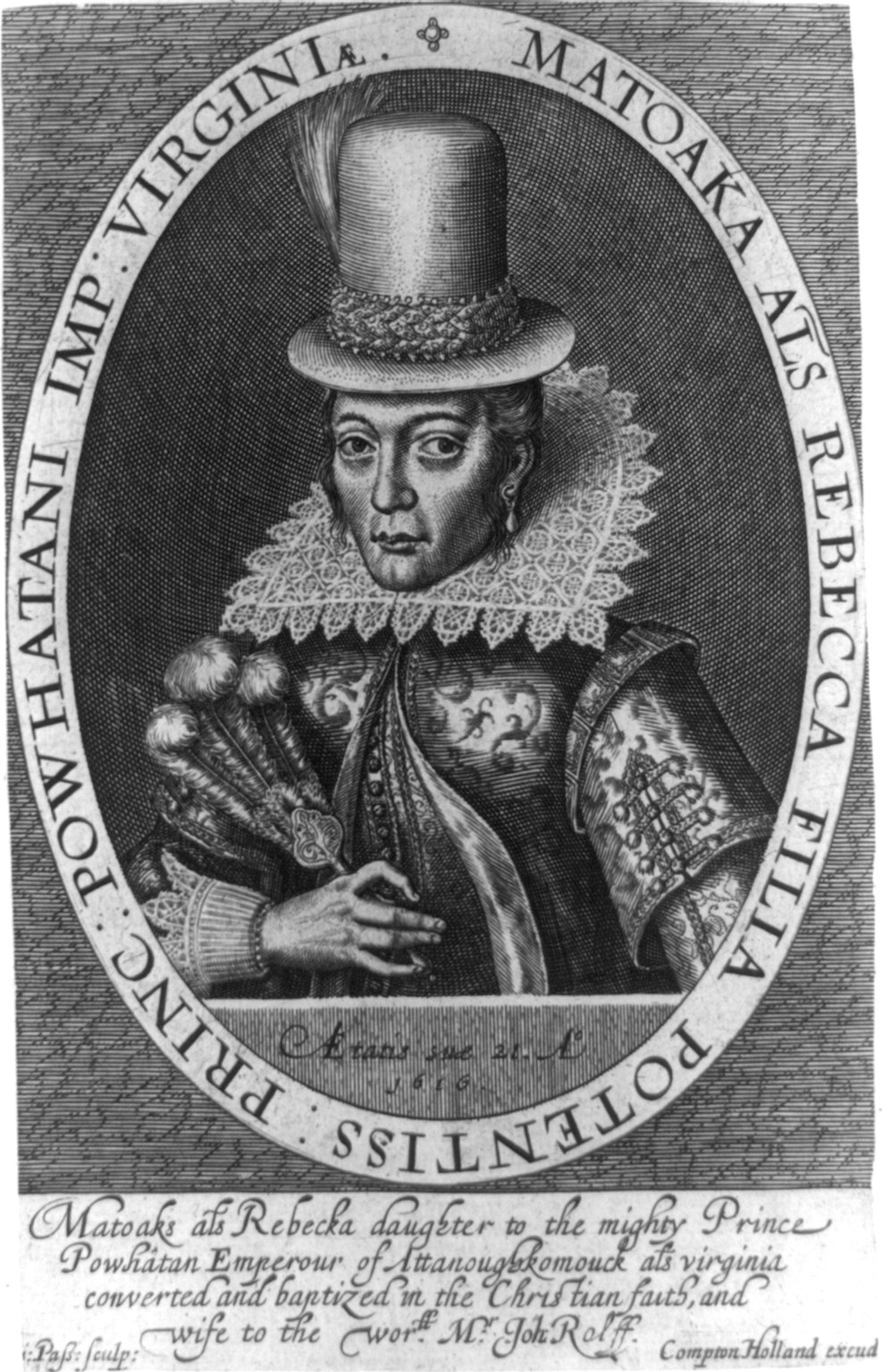
Pocahontas, the beloved daughter of the Powhatan tribe chief, was most famous for working hard to ease tensions between her tribe Powhatan and European colonists in Jamestown, Virginia.
Pocahontas was a Native American princess born in the late part of the 16th century to a Powhatan-warrior chief called Chief Powhatan (or Wahunsenaca). She was known as Amonute or Matoaka. Her name Pocahontas was actually a nickname given by her tribe as a result of her very cheerful and adventure-seeking nature.
Her tribe’s close proximity to Jamestown – the first permanent thriving English settlement – caused a lot of skirmishes in the first few years of the 17th century. The arrival of the first English settlers in 1607 was perceived by the Native American tribes near the banks of the James River as threatening. The settlers not only had to contend with starvation and harsh winter conditions (i.e. “The Starving Time”) but also they faced attacks from warrior men from Pocahontas’ tribe.
Around 1607, a young Pocahontas is believed to have saved the life of Captain John Smith, one of the leaders of the English settlers. According to Smith’s account, the Native American princess placed rushed to put herself in between a strike and Smith’s head. From then onward, Pocahontas began working as intermediary between her tribe and the English settlers. She offered them vital aid, including food, clothes and herbs to cure their illness. Her efforts helped prevent some English settlers from dying of starvation, especially during the brutal winter in 1609.
She also partook in discussions to free Powhatan warriors that were captured by the English settlers. She always hoped for peace to prevail between the two sides. In one act of bravery, perhaps defiance, she passed information to the English settlers of an impending attack from her Powhatan tribe.
In 1613, the Powhatan princess was kidnapped by the English settlers who intended to use her to bargain for the freedom of English settlers taken prisoners by the Powhatan tribe. It is unclear whether Pocahontas voluntarily converted to Christianity or she was forced into the faith. It’s also been alleged that she was abused, possibly raped, by her English captors.
While held captive, Pocahontas is said to have fallen in love and later married an English settler and tobacco farmer called John Rolfe. She and her husband Rolfe went on a trip to England, where she became an instant celebrity. Unfortunately, she died on her way back to her homeland in 1617. The distinguished Native American woman was survived by her husband Rolfe and son Thomas.
Did you know: Pocahontas was baptized and then Christened as Rebecca?
Chief Joseph (1840-1904)
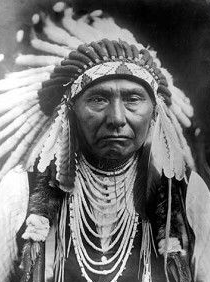
Chief Joseph’s Nez Perce tribal name Hin-mah-too-yah-lat-kekt means Thunder Rolling Down the Mountain.
As his name rightly says, Chief Joseph was the leader of the Nez Perce tribe during the Nez Perce War. Born Hin-mah-too-yah-lat-kekt on March 3, 1840, in the Wallowa Valley, Oregon, Chief Joseph was the son of a local chief called Joseph the Elder. Beginning in his childhood, he and his siblings were trained to ride and fight on horse.
Joseph was still a young boy when the U.S. government began to venture into the Nez Perce tribe lands. His father, realizing that it would be a losing battle to take arms against the U.S. government, sued for peace with the encroaching forces. Peace would reign for a period of time until the early 1860s, when gold was discovered beneath the land of the Nez Perce people. With many prospectors and investors trooping into the area, the U.S. government ordered the Nez Perce tribe to relocate from the Wallowa Valley to Idaho. That order was a clear violation of the agreement signed in 1855.
Just before his father’s passing in 1871, the young Joseph vowed to hold firm to the gold-rich Wallowa Valley. He was a wise and young chief, opting not to get into a confrontation with the white settlers. Fate had a different proposition for Chief Joseph and his Nez Perce tribe. In 1877, one of Joseph’s fighting group got into a violent tussle with a white settlement. The ensuing chaos left many white settlers dead.

The U.S. government finally found an excuse to drive out the Nez Perce tribe from their own lands. Chief Joseph retreated as his few hundred warrior men could not face the U.S. army in kind of battle. As he led his people north into Canada, he made sure to keep his people safe from U.S. soldiers. Exhausted and hungry while at the same time being hit by the freezing weather conditions, Chief Joseph took a bold decision to surrender to the U.S. government on October 5, 1877. By so doing, the Nez Perce War came to a conclusion.
The U.S. government forced Chief Joseph and his Nez Perce tribe to make a new home in a reservation in Oklahoma. They were never allowed to move back to their homeland in Wallowa Valley. In 1885, however, some members of the Nez Perce tribe were given permission to settle in Idaho.
A tactical genius, Chief Joseph took his fight to a different arena. He became a civil rights activist, calling on Washington, D.C. to provide equal rights, freedom and economic opportunities to his people.
Did you know: For the tactful manner in which he handled the Nez Perce War, Chief Joseph came to be called the “Red Napoleon”?
Other honorable mentions
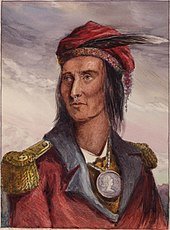
Greatest Native Americans of All Time | Image: Tecumseh (1769-1813)
- Black Hawk (1767-1838) – A warrior chief from the Sauk tribes who helped the British in the War of 1812
- Jim Thorpe (1888-1953) – A versatile sportsman who distinguished himself in many sports, including baseball, football, and pentathlon. In the latter sport, he even bagged an Olympic gold medal at the 1912 Olympics.
- Squanto (1581-1622) – Also called Tisquantum, Squanto was one of the first Native Americans to learn to speak English. He even made a trip across the Atlantic to England. In his latter life, and back to his homeland, he helped broker a peace treaty between the local Native population and the Pilgrims.
- Tecumseh (1769-1813) – famous for establishing the Tecumseh Confederacy of Native American tribes and then waging a fierce war against the United States. A leader of the Shawnee, Tecumseh struck an alliance with Great Britain to fight against the United States during the War of 1812. He and his men were vanquished by U.S. Major General William Henry Harrison (later 9th president of the United States) at the Battle of the Thames on October 5, 1813.
Other interesting facts
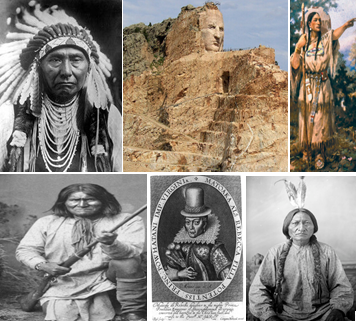
Great Native Americans of All time. Image (from top left to bottom right): Chief Joseph, Crazy Horse, Sacajawea, Geronimo, Pocahontas, and Sitting Bull
Although slow and meticulous in his ways, Sitting Bull exhibited a kind of tenacity and bravery that made him lethal to his enemies. His name changed from “Slow” to Sitting Bull after displaying nerves of steel during a battle against the Crow tribe.
For his contribution to the literacy of the Cherokee people, Sequoyah was the recipient of a number of awards, including posthumous ones. The U.S. Capitol in our nation’s capital has a Sequoyah statue.
The Chief Joseph Dam on the Columbia River is the second largest hydroelectric power facility in our nation.
Pocahontas was posthumously honored in 1907 when she became the first Native American to feature on a US stamp.
Sitting Bull, the Supreme Chief and warrior-leader of the Lakota Sioux, was revered as holy man. He would tell his people of the visions that the Great Spirit revealed to him about how U.S. soldiers fell like insects on the ground. He told his people that the spirits favored them in the mighty battle that was at hand.
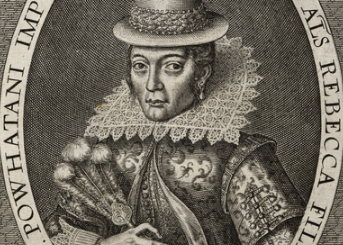

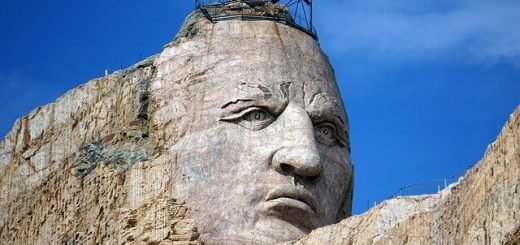

























Years ago, we were traveling through Arizona taking in some of the more famous tourist sites. We were driving from Flagstaff to Sedona by way of one of the backroads, When we came upon a small group of 3 or 4 young folks. As I drove by them, one of the young ladies gave me the figure. Right away a young man grabbed her arm and told her to stop. I do not have any native American blood in me, but I fully understand were she was coming from. Every race has dome nothing but try and did screw them from the time that the Northmen stepped ashore to now